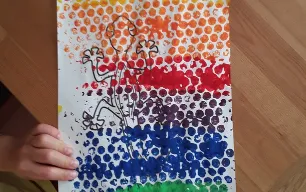What is Strewing?
A way to provide opportunities for children to take ownership of their own discoveries.

Do You Strew?
When I recently heard a friend using the term ‘strewing’ I had to check I heard the word correctly! Then I had to ask what it was, as I had never heard of this word before. So, what is strewing?
By definition, strewing is a subtle way in which parents and educators provide opportunities for children to take ownership of their own discoveries. This is achieved by subtly, but intentionally, leaving items around for children to find. This could be a book, craft items or even a nondescript items like shells. Whatever the object, there is no scheduled time to look at it or even a specific activity to complete. Children can instead take possession of their own discoveries and make their own decisions about how they move forward with the objects they have.

Strewing For Younger Children
Although unaware of this as a technique, strewing is definitely something I used to do a lot when the boys were younger. I would leave different sensory materials on the tuff tray for them to explore. I would unroll a long piece of paper across the floor for the boys to experiment in drawing different tracks for their cars.

Strewing Now…?
On first reflection I wondered if this sense of freedom and self-discovery had been lost in our home along the way. It seemed so easy when they were younger to leave something as simple as different sized pots along with some pom poms and they would spend time pouring the poms poms from one pot to another.
With further thought I realised that this freedom is still prevalent in our house today. My approach to it is just a little different. This is partly because my boys have gotten older and are no longer excited by a blank piece of paper and some crayons. But also, because I have a clearer idea of what I want us to achieve each day.

Using Strewing to Encourage Independent Exploration
So now although we spend some time each morning working towards developing literacy and maths skills, there is still opportunity for the boys to explore and follow their own interests.
I do still leave items around for the boys to discover themselves. I find that if I present an activity to them, it is ‘boring’, where as if I leave something on the table, the words ‘what’s this?’ soon reach my ears. Sometimes this is related to a topic we are learning about. When we looked at Building Bridges, I left marshmallows and uncooked spaghetti on the table. After eating a few marshmallows, the boys then began playing with the materials. It was a few days later, after their initial experimentation when I set them the specific challenge of building a bridge strong enough to hold a book. They were then happy to do this task knowing they would get to eat some of the building materials and feeling like they had already practised this earlier in the week.

More recently, Teddy discovered a World Cup 2022 football chart Jeffrey had ordered and left on his desk. After spending some time looking at which teams were in which groups, he took it upon himself to make cards showing the different flags representing the countries which will play.
This was unexpected to say the least, and really good example of the way in which children can surprise us. While we know what they broadly enjoy we cannot always predict where their interests will lead them. It is vital therefore that we create an environment to encourage this natural discovery.
What Can I Strew?
You never know what will inspire your child. Whichever item you decide to leave around may or may not entice them. Do not be disheartened by this but instead try a few different things. Here are some ideas for you to try:
- Craft materials – this can be anything from paint, to recycling materials, tape, glue, scissors, scraps of newspaper. Change the materials you leave out to inspire your child’s imagination and creations!
- Sensory materials – this might include a container of water with pots and funnels, a tray of sand, glitter, shaving foam, rice and lentils.
- Nature items – leave shells, leaves, conkers, and sticks around the garden for your child to discover.
- Books – this can range from activity books, recipe books, craft books or reading books. And don’t forget you can always get books from the library.
- Postcards – these might have interesting images of artwork or new places.
- Toys – you do not need to buy new toys! Make those toys which have been sitting on a shelf easily accessible for your child to re-discover.
Try out these topics, all of which have activities to encourage experimentation, exploration and discovery.
Year 1  | Year 1  | Year 2  | Year 2  |
|---|

Comments
Post a Comment